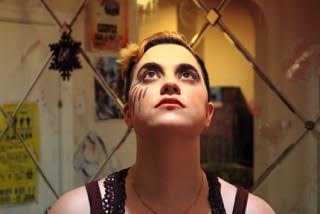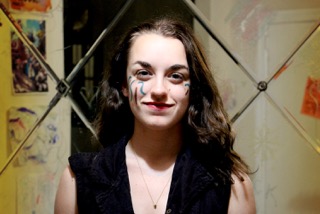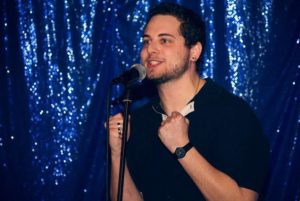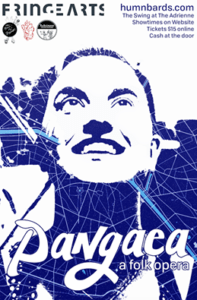PANGAEA, connecting people, life, and historical times through a post-apocalyptic folk opera: An interview with the musicians-actors and the director
PANGAEA: “About 300 million years ago, Earth didn’t have seven continents, but instead one massive supercontinent called Pangaea, which was surrounded by a single ocean called Panthalassa,” as Tia Ghose, senior writer for LiveScience, points out.
Jeremy Adam: A singer-songwriter, he studied theater at Temple University and performed at Fabio and Danny’s Café and at Dagwood’s Pub. Jeremy now works as an entertainer at Music Monkey Jungle and at Applebee’s in Tinton Falls, NJ, and is the Lead Vocalist/Singer at Third Period French. His “main goal in life is to write and perform original music. I am currently working on spreading my original music around Philadelphia.”
Travis Braue-Fischbach: “When not stage managing or assistant stage managing Fringe shows (Marbles in 2014 and Dolls of New Albion in 2015 respectively) and various other theatrical productions (Bicycle Face in 2015 and The Rover in 2016), Travis spends his time entertaining children with Music Monkey Jungle, touring Old City Philadelphia with Spirits of ’76 Ghost Tours, playing various instruments for his solo musical efforts, and touring the country as the bass player for local band GASH.”
Hum’n’Bards: Five up-and-coming young musicians-actors in Philadelphia, members of The Hum’n’Bards, turned on their computers and skyped with Jasmine Kojouri, a talented young director (who now works for Teach America out West) to have her guide the ensemble through the cliffs of creating a folk-opera from scratch. The work is being presented by Van.Martin Productions as part of the Philadelphia Fringe Festival this year.
Christina Higgins: “Christina Higgins is a Philly-local actress. Recent credits include an adaptation of Little Women (Jo March), Twelve Angry Jurors (Juror #2), and Rocky Horror Show (Magenta). When she’s not on-stage, she serves as the Audience Services and Office Manager at Theatre Horizon.”
Jasmine Kojouri: The director, working with the ensemble electronically on a regular basis via Skype, first involved the actors-musicians in various exercises to get them to think in creative ways, before all participants wrote the lyrics and the songs for the evolving production of PANGAE, a post-apocalyptic folk opera.
Anna Michael (lead artist of Pangaea): “Anna Michael is a native of Philadelphia and a graduate of Temple University’s Musical Theater Program. She has previously worked with Jackpine Theatre, The Drama Group, Hella Fresh Theatre Co., Manayunk Theatre Co., Temple Theaters, Music Monkey Jungle, The Philadelphia One Minute Play Festival, MacGuffin Theater and Film Company, Vagabond Acting Troupe, The Centre Theater, and Philadelphia Young Playwrights.”
In this interview, the director and four of the cast members share their experiences: Anna Michael, Christina Higgins, Jeremy Adam, and Travis Braue-Fischbach.
Henrik: What was the the concept development for your post-apocalyptic “folk opera.”

Anna Michael (lead artist of Pangaea): I began the process for Pangaea when I found a note that I had scribbled during a mandatory college science course. It detailed the Ordovician period when there was an ice age that led to a mass extinction. During the following years, I thought of the science on more of a personal note: “What if you were all alone on your own separate continent?” This small idea led me to the study of life that is the world of theatre—and that became Pangaea.

Christina Higgins: Anna Michael started us off with the idea of the earth splitting further apart, as Pangaea did in the beginning of time, and people existing on small islands and trying to communicate. We went from there.
The concept was Anna’s brainchild definitely. As far as making the material goes, we devised this piece over the course of three months. Our director, Jasmine, would offer the group assignments and through these assignments songs, dances, monologues, etc. were created. From there we picked what fit the concept most, merge some pieces together and created one cohesive experience.

Jeremy Adam: Anna brought the idea to each of us individually and asked our general thoughts on the world that she had made up. From there, we signed on to the cast and at our first rehearsal we had our first in depth conversation about the reality of the world we were creating, and we started making decisions and basic ground rules.
One of the hardest things for me was having faith that the rules that I was defining made sense and were “allowed.” As the weeks went on, we were given assignments by our director which were totally open-ended (and seemed to be all over the place), but really gave us a chance to express our individuality and start to flesh out our own characters. A huge part of the process was supporting each other and that translated perfectly when we started to actually write pieces together.
Your musicality stood out. How did you work on your own piece of music—first alone and then in collaboration with your team mates?
Anna: I have a musical theatre degree from Temple, which taught me a more classical approach to the genre, including Rodgers and Hammerstein. But during college, I was also involved with more experimental work, including Philadelphia Young Playwrights and original student pieces. I enjoy the process of collaboration and seeing what others can add, which is why I decided to do a devised piece—instead of just writing the piece alone.
Christina: While I am trained in music, my own style of music is actually quite “lyrics-first” centered. When I was working on my own pieces, the musicality of it was always my second thought. Throughout this process, I gained a lot more comfort and ability to join in and contribute musically. Someone would sing a song, and then we’d all jump in with different instruments, harmonies, and so on.

Travis: My experience was unique in this case, in that I started as a stage manager and musical director before becoming a full ensemble member. That said, I mostly witnessed the musical pieces when they were brought into the ensemble. Generally, each songwriter would show us the piece, and then allow us to build upon it. I have contributed some chord progressions, vocal harmony suggestions, and a lot of additional musical instrumentation.
Jeremy: Some of the songs that are in the show had been written by me prior to starting the project. If I found that some of the music I had already written was appropriate for whatever the week’s assignment was, I would play it for the group and we would then collaborate on adding more instruments or vocal parts. It all just came together smoothly. When it came time to start working on assignments during rehearsals, the group cohesiveness that we had created helped us immensely to make decisions and stick to them or discard anything we weren’t in love with.
What songs have you wriiten for the show, and how have the songs blended in with those of your fellow composers?
Anna: The one song I am most proud of is “Our Dying Song.” It is the finale song and sums up what the show means for me. I wrote the lyrics to the song, but some of the music and the harmonies were created in our rehearsal process.
Christina: My songs are heavier on story, which helped provide a good mix of plot within the piece. Everyone’s pieces also had their own stories, and our songs evolved to match each other in the plot of the piece.
Travis: While I didn’t offer much in the way of original music, I am nonetheless amazed by how well the songs of the ensemble seemed to blend together. I think it speaks very well of our rehearsal process that the ensemble was able to achieve such unity.
Jeremy: My music has its own eccentricity and uniqueness to it; yet, somehow, the style of music of my fellow cast members was eerily similar. The upbeat, sometimes simple melodies mixed with deep, thoughtful lyrics, radiated the same vibe that many of my fellow actors/writers/composers were going for so that our music fit together naturally.
Jasmine, You directed this cheerful-serious-hope-inspiring musical with the cast via Skype. You were ‘present’ at your rehearsals only electronically, taking notes, and then having all of your cast watch the interactions on their laptops or cell phones. What was that like for you Jasmine and for you – the actors?

Anna approached me with the idea, I instantly fell in love with it, and I wanted to be a part of the process any way I could. We both talked and realized having a director thousands of miles away would mirror the show’s themes and explorations. With the technology available to us like laptops, tablets and Wi-Fi, it wasn’t that difficult to serve as a director for the piece.
I would be on a laptop during the rehearsal and would watch, observe, and comment like any other show. It truly speaks to the actors’ strengths of being aware of the limitations. I don’t have a 360 view of the room but the cast members were always conscious of my presence, and I felt physically connected to everyone in this project.
Christina: Very interesting! But in a good way. It’s exciting to be part of a process where the director and everyone involved truly understands the benefits of technology, especially since that’s such a key part of our show. Save some connectivity issues (donate to The Hum’n’Bards now to buy us a Wi-Fi hotspot), she might as well have been there in the flesh.
Travis: Having known Jasmine beforehand, I knew we were in good and capable hands. She approached the rehearsal process with an almost childlike curiosity, allowing us to play with the concept, but always knew when to reign us in. It may be hard to believe that someone can be so hands-on from many miles away, but this show is not like anything else.
Jeremy: Working with Jasmine was a dream. At first, it was weird to have to film everything that we created to send off to someone across the country, but Jasmine’s insight, creativity, and belief in all of our work was more than enough to make the process completely seamless. Her feedback was always 100% honest and she would give us advice but, ultimately, she let us make the decisions. It was a very constructive relationship and I would love to work with her again.
What would you like your audience to take home with them from your post-apocalyptic PANGAEA?
Anna: This city is my home. I was born and raised in Philadelphia, I went to school here, and have been heavily influenced by Philadelphia’s independent theatre scene. Pangaea is about community, and it means a lot to me to have the opportunity to share my vision with my community.
Christina: A lot of projects I’ve worked on have dealt with the topic of communication, because that’s such an important part of our humanity. Like Anna says in the end of the show, we’re not made to live in isolation. We’re meant to connect and support each other. I hope audiences leave with a sense of that importance.
Travis: I would be happiest if, upon leaving the theater, audience members decided to connect with their family and loved ones. Since the show is often about overcoming great distance and odds in order to communicate and love, I think if we inspire at least one person to reach out and connect with somebody somehow we have done our job.
Jeremy: Humans cannot survive alone. We must lift each other up.
Is there anything else you would like to share about this production?
Anna: This is my second time performing in Fringe, but my first time making a production happen from start to finish. As an audience member, Fringe has always been a thrilling couple of weeks, stuffed with the unexpected magic and surprises. As a creator and a performer this year, I’m very excited to be a part of the magic of Fringe.
Christina This is definitely one of the pieces of theatre I have been the most proud to work on and present to audiences.
Travis: A big thank you to everybody on the production team and in the ensemble. I am so thankful that my transition into an ensemble member was met with open arms and understanding. The ensemble welcomed me into something they had been working and nurturing for months, and the production team picked up my slack when I had to focus on ensemble life. To be fair, I never stopped sending Rehearsal reports. Once a stage manager, always a stage manager.
Jeremy: Thanks to everyone who came. Pangaea didn’t end with our closing performance. The cast will return in various locations around the city. Look out for updates on our Facebook page.
Thank you all for your beautiful but also thought-provoking show about our place in time and space.
LINKS:
2016 Philadelphia Fringe Festival 2016 Philadelphia Fringe Festival Review: ‘Pangaea: A Folk Opera’ at The Hum’n’Bards by Lisa Panzer.
Here is more information on PANGAEA.
Here is more information on future productions of PANGAEA.
Read DCMetroTheaterArts’ 2016 Philadelphia Fringe Festival reviews.






